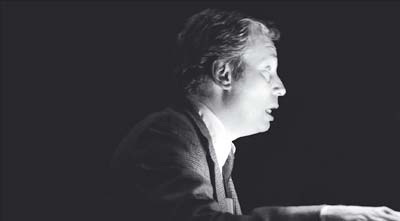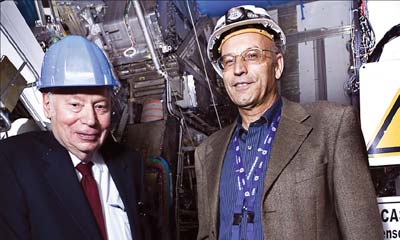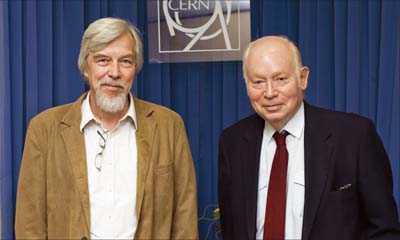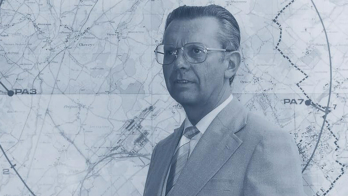The Nobel laureate talks about the changing face of particle physics.

It was no surprise that the audience arrived early in CERN’s Globe of Science and Innovation for the colloquium on 7 July. Steven Weinberg is well known for his work on the Standard Model of particle physics and for his skill in writing carefully crafted books about particle physics and cosmology. His life in physics, like that of CERN, has spanned more than 50 years of discoveries and breakthroughs. In 1979 he received the Nobel Prize in Physics together with Sheldon Glashow and Abdus Salam, for “contributions to the theory of the unified weak and electromagnetic interaction between elementary particles, including inter alia the prediction of the weak neutral current”. The latter had already been discovered at CERN by the Gargamelle collaboration in 1973. A decade later, in 1984, the UA1 and UA2 experiments at CERN were to discover the intermediate bosons, W and Z, with the masses predicted by the electroweak theory.

Weinberg first visited Europe after graduating from Cornell University, just as the provisional CERN became the fully fledged European Organization for Nuclear Research in 1954. Following advice from Dick Dalitz on where a young theorist should go for a study year in Europe, he joined the Institute of Theoretical Physics in Copenhagen, which at the time was home to CERN’s nascent theory group. He returned to Europe for a second year in 1961, this time at Imperial College, London, and in July 1962 he visited CERN’s Meyrin site for the first time, to attend the 11th “Rochester” Conference on high-energy physics. It was, he recalls, the beginning of an extraordinarily exciting period that extended until the mid-1980s. “There was a wonderful interplay between theory and experiment, with current algebra, electroweak theory and then QCD – and the brilliant experiments at CERN.” To the discoveries of neutral currents and the W and Z, he adds the success of the Large Electron–Positron collider in showing how many types of quarks and lepton there are. By the end of the 1980s, “so many things became clear that had seemed murky”, he explains, adding that at last “you could give a rationally organized course in particle physics”. The Standard Model of particle physics had arrived.

From particle physics to cosmology
Since then, he feels that the field of particle physics has not been so exciting. “The discovery of neutrino mass is the only new thing,” he says, pointing out that even this is not so new because the first signs were already there in the late 1960s in the results from Ray Davis’s solar-neutrino experiment. Instead, the past 20 years or so have been marked by what Weinberg acknowledges as “heroic efforts” to go beyond the Standard Model, for example with string theory. In his view, while these ideas are more mathematically profound than the Standard Model, they have little contact with observation. The problem facing particle physics is that “the Standard Model worked too well!”.
Back in the 1960s, Weinberg threaded his way through the theoretical jungle, reaching his unified description of weak and electromagnetic interactions in terms of an exact but spontaneously broken symmetry in 1967. This is the work for which he received the Nobel prize in 1979 and for which he is known far and wide (Weinberg 1967). He tells its story with his characteristic eloquence in the acceptance speech he gave in Stockholm (Weinberg 1979). Less universally well known is his work on chiral dynamics and effective field theories, in which he takes pride because he developed a point of view that became widely accepted. It resulted from some 15 years of work that took him from current algebra to effective field theory, with around 20 significant published papers. Together these form “a coherent body of work that changed the way people look at things”, Weinberg explains, and which has relevance to areas from low-energy hadron theories to superconductivity and gravitation. “I’m very proud of that,” he adds.
Weinberg often writes papers because he is trying to learn something. “Therefore they’re unimportant papers,” he comments. By contrast the books for which he is well known in the physics community represent the final crystallization of what he taught himself in a subject over the years, for example in the masterful three volumes on The Quantum Theory of Fields (CERN Courier May 2000 p37) and most recently Cosmology (CERN Courier May 2009 p43). He says that he never sees the books as an end in themselves – it is a bonus if they are valuable to others and he will be pleased if they become classics. Non-physicists – and probably many aspiring physicists – are no doubt more familiar with his lucid writing for the general public, for example in The First Three Minutes, which became a classic in science writing in the 1970s. Aficionados will be looking forward to his next publication, Lake Views: This World and the Universe (Harvard University Press), a compilation of essays that he has written on a wide variety of topics, from cosmology to religion.
Towards asymptotic safety
In line with his own experience in the particle physics of the 1960s, Weinberg believes that aspiring physicists should choose fields that are “messy and confusing”. Ten years ago he would have recommended students to go into cosmology. “It’s still having a wonderful run,” he says, “and it will continue to be exciting…but with the LHC, maybe it’s time for particle physics again.” His advice now would be to master both subjects – with the aid of his books, of course.

Weinberg’s current work continues to reflect his interest in both particle physics and cosmology. One aspect that he is pursuing concerns cosmological applications of “asymptotic safety” – that is, the idea of a theory that is safe from having its couplings blow up asymptotically, rather akin to the requirement of renormalization. This is leading to an approach to general relativity at very high energies that he feels is starting to look promising; the goal is an asymptotically safe quantum field theory of gravity with no problems at infinite energy. He presented these ideas in his colloquium at CERN on “The quantum theory of fields: effective or fundamental”. Beginning with a look at the fluctuating popularity of quantum field theory, he went on to pose the question: is quantum field theory fundamental or does it arise from some deeper theory, such as string theory? His recent work suggests that perhaps it is possible to have a quantum theory of gravity without strings. “I don’t want to discourage string theorists,” he says, “but maybe the world is what we’ve always known: the Standard Model and general relativity.”
Looking forward to the restart of the LHC and to the physics results to come, Weinberg acknowledges that he expects it to reveal the Higgs boson. “I have a stake in that,” he admits, referring to his 1967 paper on electroweak unification, which contained the first serious prediction of the essential scalar boson as a real particle. “The real hope is to restore the exciting environment of particle physics that we remember from the 1960s and 1970s,” he says.
• For the video of Weinberg’s colloquium at CERN, see http://cdsweb.cern.ch/record/1188567/.





